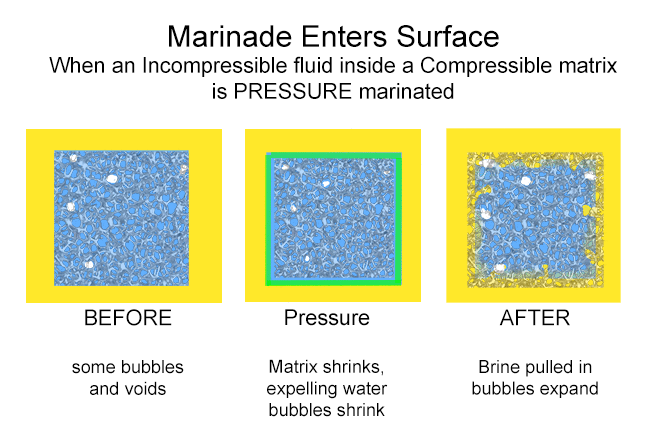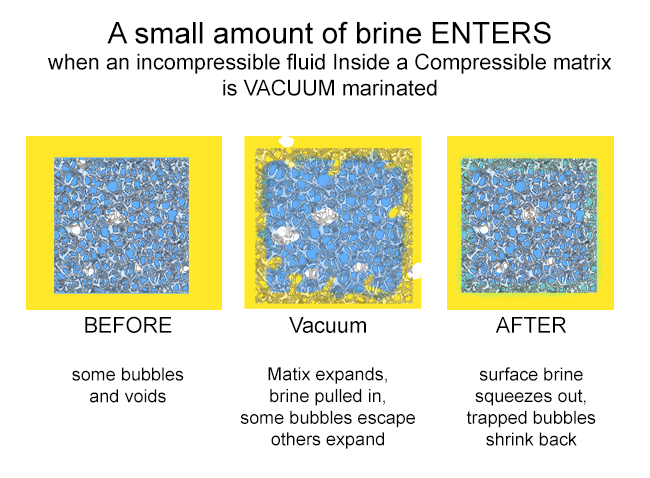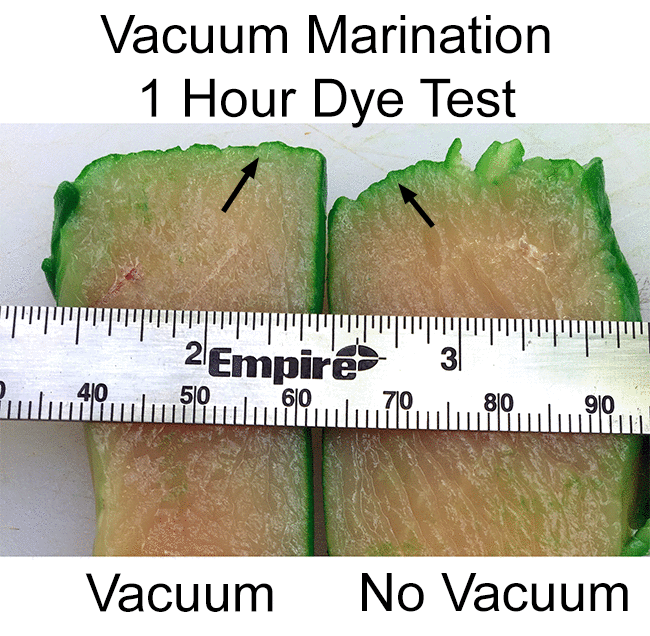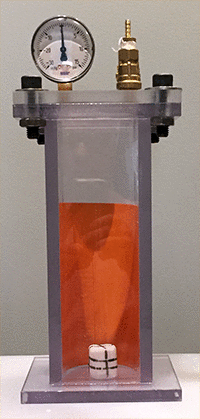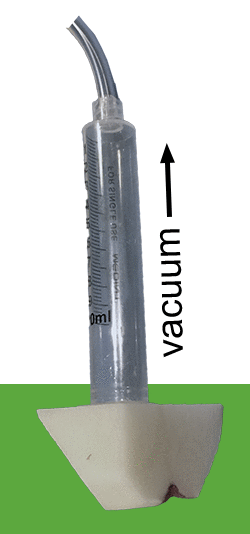| g e n u i n e i d e a s | ||||||
 |
 |
 |
 |
 |
 |
 |
| home | art and science |
writings | biography | food | inventions | search |
| vacuum sucks | ||
| June 2016 | ||
|
People are impatient, especially around meal time. Which puts pressure on the cook to to get dinner on the table. ASAP. One of the slowest steps, which might take hours or days of preparation, is pre-seasoning food in a marinade or brine. So any trick to accelerate this tedious, though critical process, is likely to be embraced on the small chance it might work. Which leads to vacuum marination. Which "ought" to work. People know that when you squeeze on a sponge it will sop up water. Meat feels a bit spongy at times, so perhaps squeezing on it with air pressure (or sucking on it with a vacuum), might help "pull in" a marinade more quickly than aimless random diffusion? And didn't someone on a BBQ message board indicate meat is riddled with pores that carry the marinade inward? Plus, I "heard" dead blood cells are full of air, and will pop in a vacuum, making room for sauce to enter. Then there was an on-line video where a sculptor de-aired plaster before molding1, and it frothed like a baking soda and vinegar "volcano". Anyway, companies sell vacuum marinators on-line, so it must be effective.... Except it doesn't work as advertised. Yet another example where common sense fails. The problem is, unlike a sponge, meat is nearly incompressible. No empty pores to speak of. All the blood drained out at the slaughterhouse (what you see on the plate is water and myoglobin), the capillaries collapsed, and meat simply shrugs off a few hours in vacuum. And I won't even address hollow blood cells.... How incompressible and pore-free? Well, meat consists of dense bundles of fat and protein infiltrated with atomically thin layers of incompressible water. Squeeze on a hunk of steak- and nothing drips out. Thankfully, meat lacks a network of interconnected pores, or bacteria could burrow their way in from the surface, making it impossible to safely cook a steak to rare, let alone tartar..... "Compressibility" is a measure of how much volume changes occurs with pressure. For example, if you press on a marshmallow (which is mostly air trapped in sealed bubbles of sugar and gelatin) with one atmosphere of pressure, it will shrink in volume by 80%. A compressibility of 0.8/atm. Nearly an air-filled balloon! Here is a short video of a marshmallow placed under 0.50 atm of vacuum, then returned to room pressure, then squeezed by 1 atm of air pressure, then released. These are exactly the levels a home vacuum marinator, or a stove-top pressure cooker, might reach. By comparison, what is meat's compressibility? Around 0.00003/atm, the same as water! Nearly too small to measure, and way too small to suck in marinade. More importantly, if the pores and cavities are already filled with an incompressible liquid, and squeezed on uniformly in all directions (e.g. hydrostatic pressure2), there is no net force emptying the "pores". In this sketch, the meat matrix is portrayed by the interconnected silver mesh, the juices are blue, and the brine is yellow. Since all three are essentially incompressible at levels reached by home marination equipment, there is no volume change when marinated, and no "pumping action" to pull the marinade inside.
Now, industrial pressure systems can reach much higher pressures than at home. For example, High Pressure Pasteurizers (HPP) routinely approach 10,000 atm. At these enormous pressures, molecular chains are bent and bonds broken. In some cases, bacteria are disabled before flavor molecules are muted. Fruit smoothies and guacamole are often HPP'd right in their serving container, leaving them safe to eat while maintaining their bright fresh flavors and colors. At 100 psi, meat remains untouched. Dense and pore-free. Some vegetables, however, will "snap" under the pressure. An apple is twenty five percent air (which is why it bobs), peaches around ten percent, and a potato less than one percent. These trapped air bubbles provide structure and support to the adjacent cell walls, like bubble wrap around a champaign glass. At around 100 psi, inter-cellular air chambers crack open, admitting marinade. But meat? It tears, rather than snap apart. Still, how *would* pressure-assisted marination work, if meat actually contained air bubbles and was modestly compressible? Pressure and vacuum would behave slightly differently in marination. Imagine the meat protein matrix was slightly compressible. When you squeezed on a hunk of meat, the matrix would shrink, expelling some of the entrained, incompressible water. The blue expelled water and yellow brine then mix to form a green layer in this sketch. Any air bubbles inside the meat would shrink and compress1, but not shift around. After a few minutes, the green, blended layer dissipates. So when the pressure is released, the matrix expands like a sponge, and sucks in the yellow marinade. In principle this method speeds up marination, but as we noted above, if meat's relative volume changes by only 0.00003 with 1 atm of pressure, the pressure-marinated layer is undetectably thin.
In many ways, VACUUM marination is even less effective. Why? Well, a vacuum stretches and expands the matrix, like a compressed sponge released under water (or in the vacuum stage of the marshmallow video above). This would pull-in a layer of marinade near the surface. Any entrained bubbles would also expand due to the lower pressure, and if they were close enough to the matrix surface, float away and pop. But most of the bubbles are locked inside the matrix by forces much stronger than mere buoyancy. They are trapped. When the vacuum is released, the matrix and the remaining bubbles return to their original dimensions. Most importantly, any marinade that was pulled in during the vacuum step is EXPELLED when the matrix shrinks back. In other words, the vacuum marination process is nearly reversible, and thus particularly ineffective. The most you could expect to accomplish is for some of the flavor molecules to preferentially "stick" to the meat. Except meat doesn't expand in a partial vacuum.
We tested vacuum marination efficacy by using green food coloring as a surrogate for the large herb and spice flavor molecules that saturate marinades. These two chickens breasts were placed in dye for an hour at room temperature. The vacuum marinated breast rested in a clear plastic vacuum chamber, evacuated by a Food Saver pump. The second breast soaked in a small glass bowl. Note the Food Saver pump is only strong enough to pull around half an atmosphere of vacuum (which is why the marshmallow above didn't inflate to the size of a honey dew melon). As you can see, there is no consistent difference between the two methods:
Clearly, don't bother trying this at home. There is some evidence high pressure (1500 atm) marination is slightly effective, but vacuum marinators are a non-starter. It is true that tumbling in a vacuum helps break up muscle fibers, and increases tenderness. But as the authors of this study on fish fillets remarks "Contrary to conventional industry belief, vacuum during tumbling did not affect the uptake of marinade". And in a different study on chicken fillets, "Under the conditions of this study, use of vacuum during marination appeared to offer no significant advantage over marination at atmospheric pressure." Go ahead, vacuum marinate dinner in a plastic pouch. It is neat, tidy and sanitary. But don't expect it to marinate any faster than in a bowl, and there is a chance meat hiding in the center is blocked from touching the marinade. Me? I marinate in a zip-lock bag, toss around now and then, and leave plenty of time for diffusion to work its magic.
|
||
|
--------------------------------------------------------------------------------------------------------
1 Casting compounds are usually a two-part blend of liquids that expand with air bubbles during mixing. Vacuum de-airing effectively removes those bubbles before the part is cast. But, unlike meat, a casting compound is a viscous liquid, so eventually air bubbles will rise to the surface and burst. In meat, they are trapped. Similarly, when laminating carbon or fiberglass panels (e.g. a matrix of fibrous sheets infiltrated with epoxy), air bubbles in the epoxy cannot push their way to the surface through the dense matrix. So, instead of a vacuum, these parts are generally pressure laminated to squeeze any trapped bubbles down to specks, where they freeze in place as the epoxy cures. If there were large, empty pores or channels in meat waiting to suck up marinade, the measured compressibilities would be much higher than water. And you would notice a large stream of air bubbles emerging under vacuum. Instead, as this video of a chicken breast in water under vacuum indicates, small bubbles emerge from every location. Just like bubbles in soda that appear when the lid is popped off and the pressure released, invisible dissolved gases link up and form temporary bubbles. They "nucleate" on-scratches in the wall of the container, on the surface of the chicken, and inside the bulk of the liquid. Then float away. But they don't leave behind an empty spherical cavity, anxiously waiting to receive a flood of marination under vacuum: (In this higher higher resolution video which opens in new window you can watch as bubbles emerge in the bulk of the water, as well as on the meat and other nucleation centers). 2 What about an unbalanced force? For example, only apply vacuum to one side of a chicken cutlet, hoping to pull liquid from the marinade through the meat into the vacuum chamber? We tried this method on chicken and potatoes - and discovered the slab of food simply acted like a cork, plugging up the end of the vacuum wand. No channels, no flow of juices, no increase in marination speed.
|
||
 Contact Greg Blonder by email here - Modified Genuine Ideas, LLC. |

